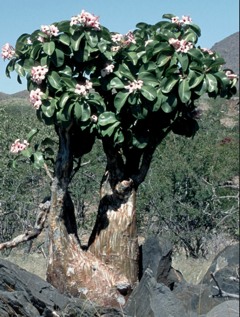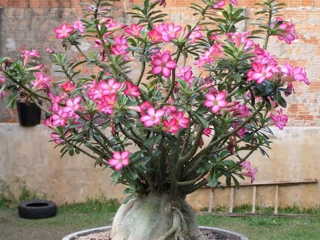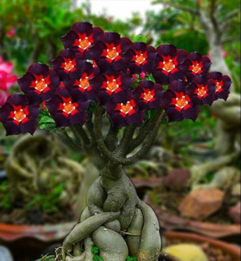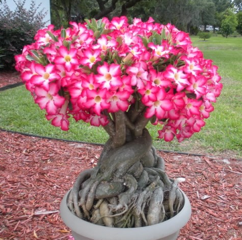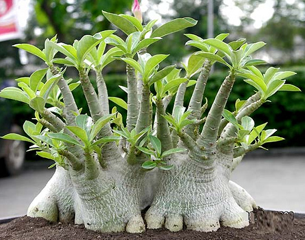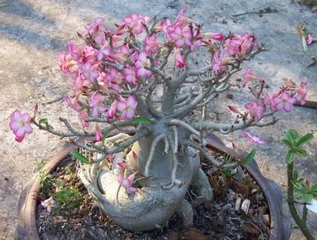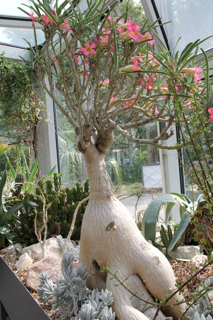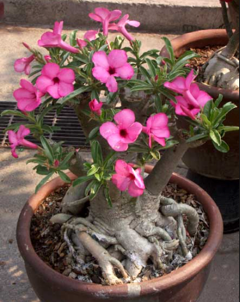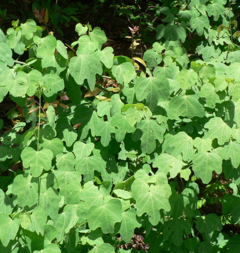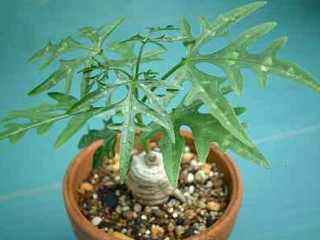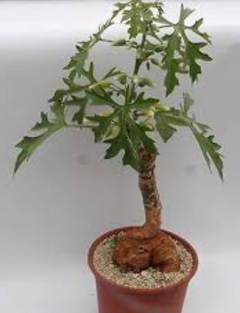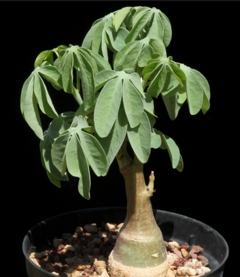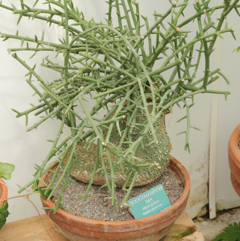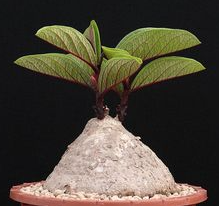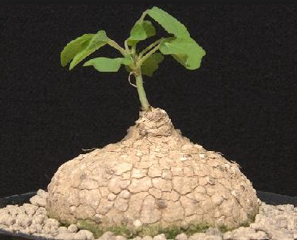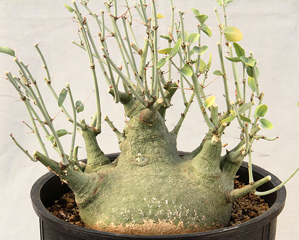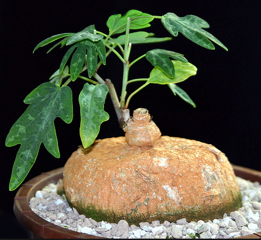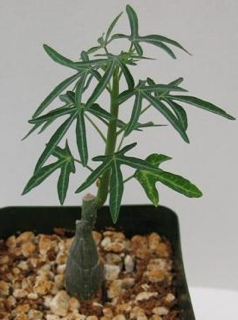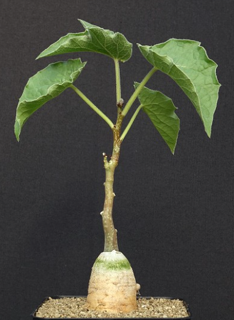Submitted by: Jim Tanner
Contents: Adenium, Adenia, LATIN LOOKUP
Adenium is a member of the Apocynaceae, and a relative of Pachypodium, Oleander, and Vinca. The Apocynaceae is home to many showy flowering plants used for ornamental and medicinal purposes. Oleander is a staple of much of Southern California Gardening, Vinca is grown over the world.
Adenium are native to Africa. Adenium are easy to grow, requiring only good fertilizer, and lots of water when in growth, and protection from cold and damp when dormant. Some growers place their plants in their garages in late fall to force dormancy, and protect them from cold and damp. Adenium hybridization for caudex shape and flower color is being undertaken around the world.
Adenia, a plant entirely unrelated to Adenium, is a member of the Passiflora or Passion Flower family. Most of the collectable adenias have large bases that support climbing stems or branches. In habitat they are often found in brush, with the branches scrambling up through brush, or alternately growing in a open area, entirely covered by a sprawling mass of live and dead stems.
In cultivation the sprawling stems are regularly pruned to keep the plant good looking in a pot (as well as transportable). All of the adenia are cold sensitive, particularly when young, and should never be exposed to cold and damp.
Tom Glavich
LATIN LOOKUP – Loquerisne Latine (Do you speak Latin)?
The meanings of latin plant names on this page – from http://davesgarden.com/guides/botanary/
- aculeata [ah-kew-lee-AY-tuh, a-kew-lee-AH-tuh]
Prickly, thorny. - Adenia [a-DEE-nee-uh, a-DEN-ee-uh]
Named for Aden, a small country south of Saudi Arabia, where the species is native. - Adenium [a-DEE-nee-um]
Named for Aden, a small country south of Saudi Arabia, where the species is native. - Apocynaceae [a-pos-ih-NAY-see-ee, a-pos-ih-NAY-see-eye]
Family name for the dogbane family; from the Greek apo (away from or away with) and kuon (dog). - arabicum [a-RAB-ih-kum]
Of or from Arabia. - digitata [dig-ee-TAH-tuh, dij-ee-TAH-tuh]
Finger. - ellenbeckii [el-len-BEK-ee-eye]
Named for Dr. Hans Ellenbeck, German physician who collected plant material on Berlanger’s expedition to Abyssinia. - glauca [GLAW-kuh]
Bloom has thin powder (like plums). - globosa [glo-BOH-suh]
Spherical. - multiflorum [mul-tih-FLOR-um]
Many flowers. - obesum [oh-BEE-sum]
Fat. - Oleander [oh-lee-AN-der, OH-lee-an-der]
Olive-like. - oleifolium [oh-lee-ih-FOH-lee-um]
Having leaves like Olea (Olive genus). - Pachypodium [pak-uh-PO-dee-um]
Thick foot. - Passiflora [pass-iff-FLOR-uh]
Passion flower. - pechuelii [pesch-WEL-ee-eye]
Named for Dr. Eduard Pechuel-Loesche, 19th century German scientist and explorer in Africa. - racemosa [ray-see-MO-suh]
Having racemes (a type of flower cluster). - socotranum [so-koh-TRAY-num]
Of Socotra, a Yemen island in the Indian Ocean at the mouth of the Gulf of Aden. - somalense [soh-mal-EN-see]
Of or from Somalia, Africa; sometimes spelled somaliense. - spinosa [spy-NO-suh]
With spines. - swazicum [SWAZ-ih-kum]
From the Royal Kingdom of Swaziland, South Africa. - venenata [ven-en-AY-tuh]
Poisoned, drugged or enchanted. - Vinca [VIN-kuh]
To bind. - volkensii [vol-KEN-see-eye]
For 20th century German botanist Dr. Georg L. A. Volkens.
